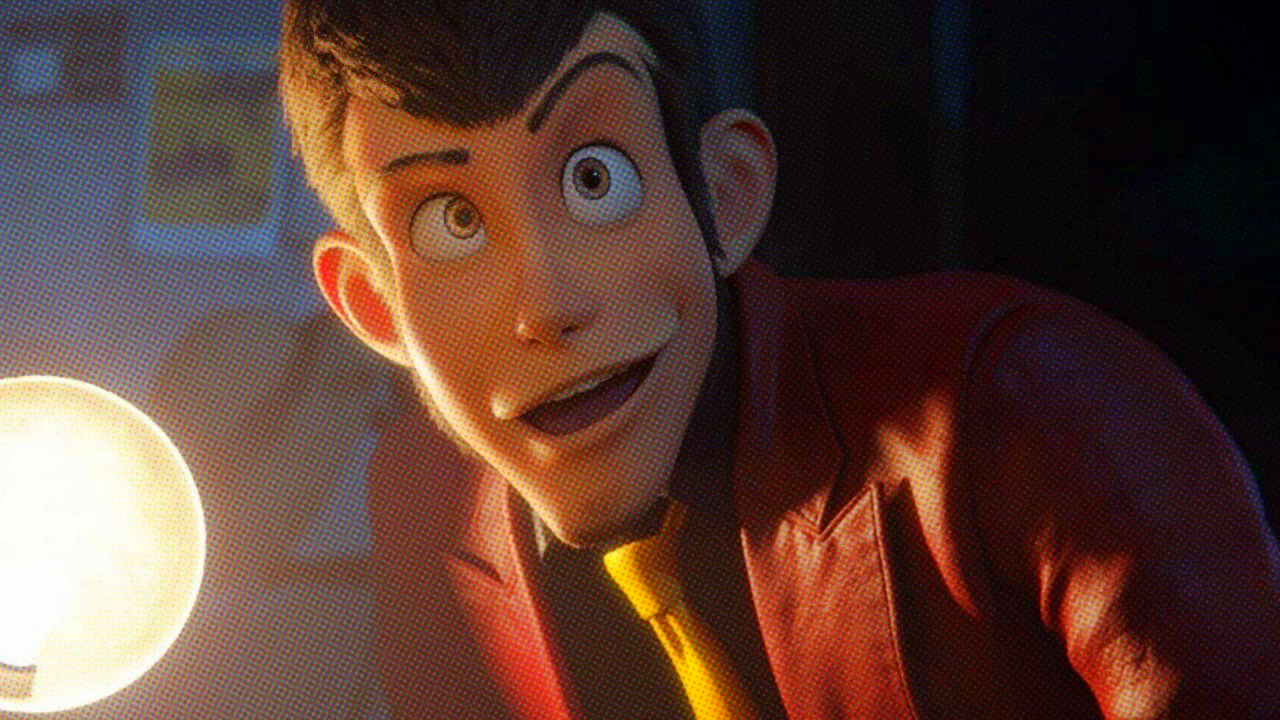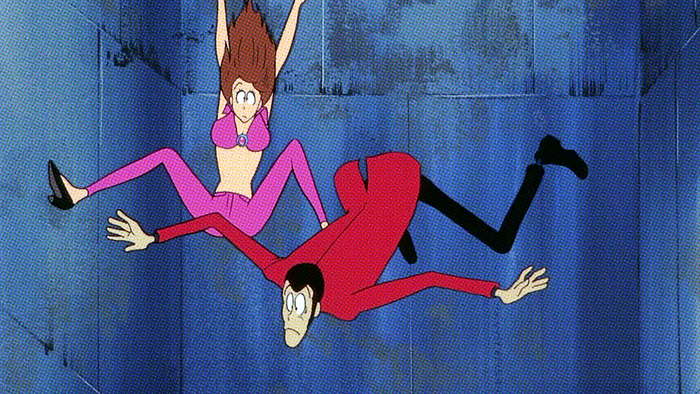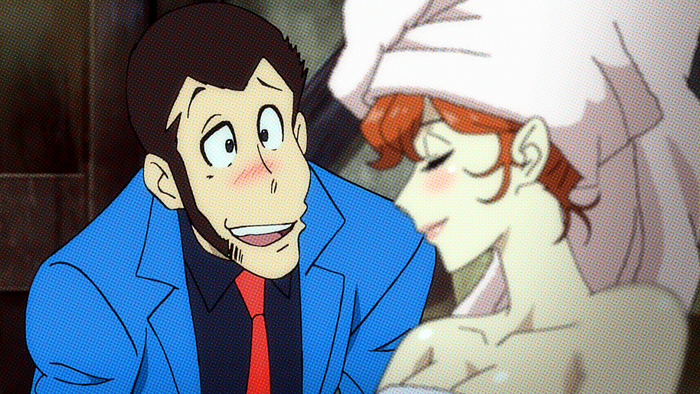It Is Ridiculously Easy To Love “Lupin III”
And I’m gonna help you, because we’re friends like that.

Let me preface this by saying that there are two types of good anime: there’s the stuff you already need to like anime to enjoy, and there’s the stuff you don’t.
This is not to diminish the value of either one - rather, to acknowledge that the conventions of anime are not particularly accessible to everybody. It just doesn’t do it for some people, and that’s fine. However, I think that a lot of great work that falls into the latter category often gets swept under the rug, and as someone who wouldn’t really consider themselves an anime fan, I feel it’s my responsibility to share the wealth when I fall head over ass for a show like this.
With that being said, you (yes, you specifically, you) absolutely, 100%, regardless of whether you like anime or not, would enjoy Lupin III.

As the upcoming Lupin III: The First (yes, that’s what it’s called- hey, we got away with Doug’s 1st Movie) inches closer to North American theatres, I regularly see commenters asking how much they need to know about the franchise going in, eager to come out for the film’s impressive animation but uncertain about how well they need to know the series to get anything out of the plot. Okay, fair: it’s pretty ubiquitous in Japan, but while it has a sizable fanbase in the States, general knowledge about the series is not something most people will have on hand. Besides, this is a fifty year old franchise; anime juggernauts like Naruto and One Piece are not particularly user-friendly if you haven’t either started from the beginning and worked your way down the vast library of content, or done an extensive amount of research - and those series are only about half as old as Lupin. Surely, even watching a fairly mainstream release will require some level of familiarity with the franchise?
I can say pretty confidently that it won’t. Because literally no Lupin content requires you to be familiar with the series already.
Here is the extent of the knowledge you want to have going in, if knowledge you must have. Nine times out of ten they’ll tell you all this anyways, but I know some people can’t trust like that, and I see you, and I’m gonna break everything down for you, okay? Okay.
Arsène Lupin III: A cocky, world-famous gentleman thief and a massive horndog.
Daisuke Jigen: Master assassin and Lupin’s right hand man. Would be very good friends with Ron Swanson from Parks and Recreation, and by “friends” I mean “two people who mutually acknowledge that they both love guns, smokes, and being grumpy 24/7.”
Goemon Ishikawa XIII: He’s Samurai Jack but if he lived in the 60’s instead of the distant future. Has a sword that can cut anything, which is both a threat and a challenge.
Fujiko Mine: A slinky con artist and the most frequent object of Lupin’s affections. Usually pulling off her own schemes on the sidelines, or double crossing the boys and stealing the loot from their schemes.
Inspector Zenigata: A cop so determined to catch Lupin that he once flatlined and somehow resuscitated himself at the mention of Lupin’s name.
They steal shit.
End of article. You’re welcome.
Ok, my point is that this is a very character-driven franchise, built on a rock solid formula: a series of stories which really serve as frameworks for the main cast to use as a playground. You know what you’re gonna get - some wild capers, madcap chases, people ripping off latex masks - but the fun is figuring out how you’re gonna get it. It’s weird: the best analogue for its structure is probably Scooby-Doo, but even Scooby-Doo has historically had less faith in its own tried-and-true formula than Lupin has, occasionally resorting to new cast members and short-lived gimmicks to punch things up. Lupin is like bread: you’re always gonna need the same basic components to make it work, but that doesn’t mean there aren’t a million ways to make really good bread.

It helps significantly that, also much like Scooby-Doo, there’s little to no continuity between each entry. At the start of your typical Lupin story you’ll meet the gang in medias res, and usually leave them as they make their getaway to the next grand adventure. Arcs for members of the main cast are usually self-contained. There is no greater-scope villain haunting them from past escapades, constantly out of reach: not even Inspector Zenigata, who’s really just the honorary fifth member of the gang. That isn’t to say the series has never changed - Fujiko plays the damsel in distress far less often than she did in the 70's, and the most recent anime series, Part V, frequently addressed the difficulties of working around facial recognition software and social media - but it knows which elements just don’t need to be changed, and that confidence is part of the reason it’s not only still successful, but still fun.
(Side note: Lupin is exactly the kind of series that’s conducive to a drinking game guaranteed to get you hammered — but if you even so much as sip every time Zenigata angrily shouts Lupin’s name, I can say with 100% certainty that you will not survive the night.)
And this commitment to remaining timeless makes the cast a constant delight. Lupin himself is relentlessly likable: a goofy mischief maker whose colorful suits, friendly demeanor, and skirt-chasing bad habits bely a cunning and enigmatic mind. He and his partners tease and bitch amongst themselves, but it all comes from a place of genuine camaraderie after years of working together. Even Lupin and Zenigata, sworn enemies on opposite sides of the law, share a great deal of mutual respect, and will often drop the cat-and-mouse chase to help each other out of any serious trouble. You start to understand why these people would follow one another to Hell and back, just by the warmth and familiarity of their dynamic - and at a certain point, you start to consider yourself a member of the gang.
So you may be asking, “alright, well, now I’m thinking of dipping my toes in, but I still don’t know where to start. How about the first movie, The Mystery of Mamo?”
Answer: Don’t do that.
( Seriously, don’t do it. )
Here’s the thing: your long-term engagement with this series kind of lives or dies based on whether or not you like these characters. I’d compare it to It’s Always Sunny in Philadelphia - you’re gonna be spending all your time with this central group, so if you don’t fucking like them, you’ve lost about half the appeal.
See, Mystery of Mamo is a reflection of both the era it was made in and the manga it was based on, which means that Lupin himself is, um…well, a whole lot less consent conscious than he is in the vast majority of iterations that follow. No, he doesn’t actually succeed in committing any sexual assault at any point in the film’s runtime, but damn if he doesn’t try. Even with that aside, he’s much more of a bastard than usual, which is fine if you already like him, but will definitely start you off on the wrong foot if you don’t. It’s a trippy bit of scuzzy, scrappy 70’s animation that’s a fun relic if you’re endeared to the franchise going in, and can handle some questionable plot elements (which, if not, that’s entirely valid: Mamo really isn’t quintessential viewing) but it is not a good entry point by a long shot.
Speaking of which.

The Castle of Cagliostro is a curious film - albeit one I’ve discussed at length before, so I won’t go too deep into it - in that it’s a great gateway drug for the series, and honestly just a great film all around, but not exactly indicative of the franchise’s personality as a whole. You still get the standard story structure of a Lupin adventure, but the characters themselves are a little cuddlier than you’ll typically find them to be (with maybe the exception of Zenigata, who requires the least adjustment to a Miyazaki film of the group.) Lupin’s not the nicest of Hayao Miyazaki’s protagonists, but compared to some of the darker versions of the character, Cagliostro’s Lupin is a Boy Scout. Still, he and the rest of the gang are just as mischievous as usual, and the tone of the film as a whole is a pretty good gauge for where in the franchise you want to go next.
If you want something way darker, you have The Woman Called Fujiko Mine and its three tie in movies, or the original manga. Want to keep things relatively light, you have Part III, and to an extent Part IV (featuring one of my favorite concepts for a ridiculous anime villain ever - Leonardo Da Vinci, but he’s a clone, and he’s JACKED.) Everything else usually thrives in the middle ground - never overwhelmingly intense, but always packed full of adventure, heart, and raunchy fun. Admittedly, some Lupin is cornier than others - which is a natural consequence of being a franchise this old - and I would never put on airs and claim it’s all aged well, but having no continuity means you can curate your experience with the series to your liking and avoid the stuff you find questionable.
I’m gonna give you a quick timeline of my own journey from “I watched Cagliostro once and thought it was cool” to “incensed enough to write a whole goddamn article about this,” in order to give you an idea of how easy it is to watch Lupin in a way that suits your tastes. This is everything I’ve seen thus far, no omissions. For context, this started in about mid-2018, when Cagliostro dropped on Netflix, but actually picked up somewhere within the past month and a half.
The Castle of Cagliostro: You give me only one Miyazaki movie on Netflix, you know I’m gonna watch the hell out of it.
WHO WANTS CHICKEN NUGGETS (Lupin III Out of Context 2): There are actually multiple videos compiling wacky, out of context moments from the dub of Part II, but this was the first I saw, and far and away my favorite. If you won’t watch a video featuring lines like “Ah, the old ‘exploding bear trap in the ass’ trick,” you’re just depriving yourself. It’s also a good introduction to Part II (aka “Red Jacket”) and most of the dub cast of the upcoming The First, who are also featured in -
Lupin III Part IV/V: The “Blue Jacket” seasons — I watched these back to back, and while I personally preferred V, IV was still a solid time.
Farewell to Nostradamus: It seems that some of the animators from Animaniacs jumped in on this one, because the animation is suspiciously springier than usual. The whole thing’s on YouTube, by the way. I don’t know if I’d get in trouble for linking it, but, y’know, it’s there if you want it.
The Mystery of Mamo: Fun fact about this movie — it has four English dubs. I went with the dub featuring that aforementioned Part II cast, because at this point I’m a creature of habit. The main villain was also apparently designed to look like Paul Williams in Phantom of the Paradise, and if that doesn’t tell you this film was made in the 70’s, nothing will.
(I also watched one episode of The Woman Called Fujiko Mine a number of years ago, but I was a wee, prudish 14 year old and as soon as I caught sight of a nipple I bailed, so I don’t think that counts.)
This franchise is designed for you to take away whatever you want from it: it’s accommodating to newcomers, engaging to fans, and forgiving to those who’ve taken some time off. You can jump in now, you can wait for The First, or you can just rewatch Castle of Cagliostro on loop, and these are all completely valid and satisfying ways to enjoy Lupin. It’s an immensely rewarding viewing experience no matter how you choose to pursue it, and if you, like me, find the series has stolen your heart, you’ll be glad to hear the gang is showing no signs of slowing anytime soon.

